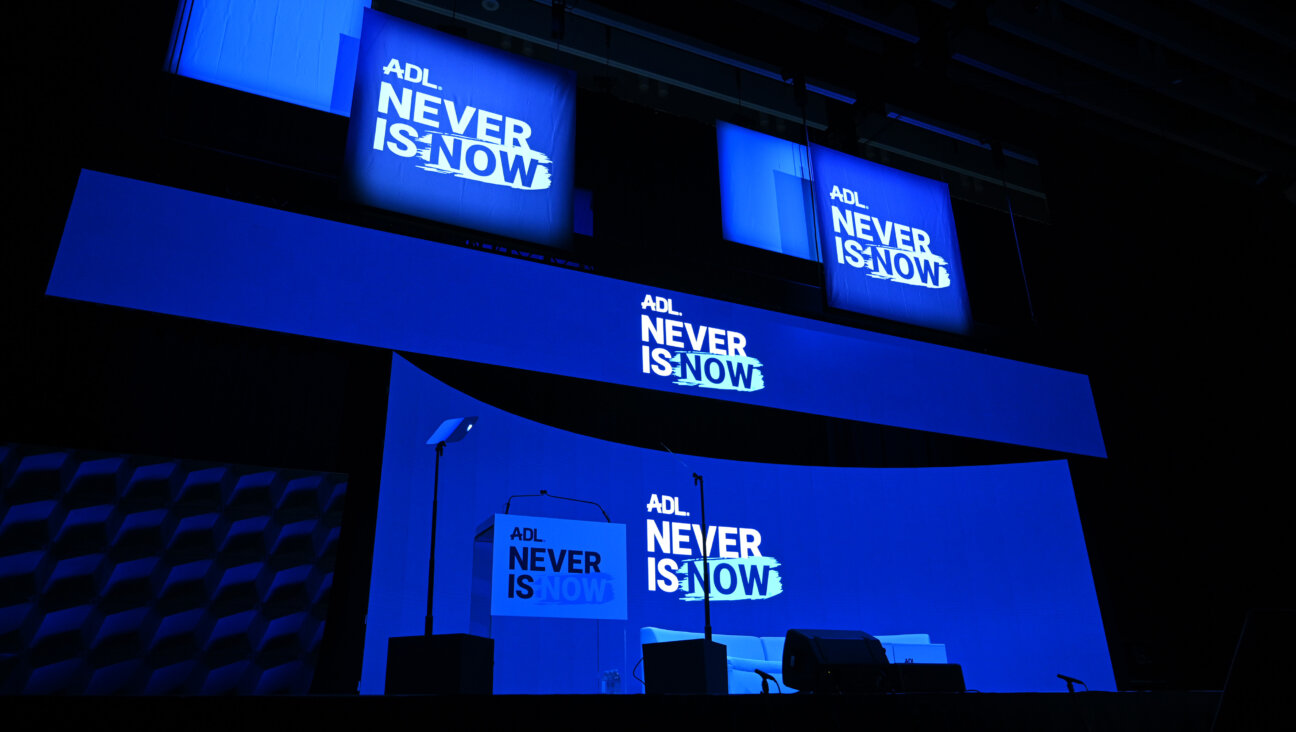In Los Angeles and Beverly Hills, protests leave behind destruction

National Guard stationed outside Canter’s Deli Image by (Danielle Berrin)
At 6 a.m. on Sunday morning, building security alarms were still ringing at retail establishments in the affluent Los Angeles neighborhood around the Beverly Center, where the night before, what began as a peaceful protest for racial justice took a darker turn into destruction, looting and vandalism.
LAPD had cordoned off the hardest-hit areas, including the historically Jewish Fairfax District and parts of La Cienega Boulevard, where shattered glass spilled onto sidewalks and debris littered the streets. From empty iPad boxes to broken clothes hangers, a trail of destruction was left in the wake of a seemingly indiscriminate wave of looting that targeted everything from national corporate chains such as TMobile and Target to small local businesses, like optometry, pharmacy and florist shops. Many establishments, including a pet store, were pillaged and plundered, with empty shelves and displays visible from the street.

Conroy’s Flower Shop on the corner of La Cienega and San Vicente was vandalized. Image by Danielle Berrin
Los Angeles was among a number of cities impacted by protest and violence as part of a national uproar over the killing of George Floyd, an unarmed black man whose neck was knelt on for several minutes by a white Minneapolis police officer. Floyd’s death appears to have been something of a tipping point in long-simmering racial tensions over police brutality towards African Americans — which in Los Angeles, has roots in the Rodney King riots of 1992, and which more recently launched the Black Lives Matter movement.
Combined with the devastating health and economic consequences of the Covid-19 pandemic, in which people of color have been disproportionately affected, tensions boiled over and thousands took to the streets in the name of racial justice. But what many say began as a peaceful protest turned violent and chaotic when protesters unleashed their rage onto symbols of privilege and value in predominantly white, affluent — and in some cases, Jewish — neighborhoods.

Windows were smashed in several places so looters could raid Off Fifth, Saks Fifth Avenue’s discount outlet at The Beverly Connection Image by (Danielle Berrin)
Although some Jewish establishments were targeted in the melee — including a synagogue that was vandalized with graffiti — the iconic Canter’s Deli and Western Kosher in the Fairfax District came out unscathed, despite their sitting in an epicenter of the unrest.
“I’m just happy to be able to go to work today,” said Yisroel Dubov, 29, an employee at Western Kosher.
The destruction came as many stores in Los Angeles had just begun reopening in the aftermath of the coronavirus shutdown. After months of sheltering in place, a sense of pent-up rage was visible everywhere. Throughout the Fairfax District and in other areas, racially charged graffiti was visible, with the phrases “No Justice No Peace,” “F—- the police” and “Defund the LAPD” scrawled on countless buildings.
But by 8 a.m. on Sunday, both Western Kosher and Canter’s Deli were open for business, with Canter’s serving coffee and pastries to passersby who came to photograph the scene. Just outside the entrance, National Guard troops called in the night before by Los Angeles Mayor Eric Garcetti were stationed next to a Humvee.

National Guard stationed outside Canter’s Deli Image by (Danielle Berrin)
Dubov, the Western Kosher worker, said he had been unaware of the protests until late Saturday, since he was observing Shabbat, but that coming to work in the morning “felt a little weird.” He said he didn’t think the protests appeared to have any anti-Semitic undertones. “The thing I’m excited about is seeing people cleaning up,” Dubov said.
One of those good samaritans was Brian Dubois, a jeweler, who drove from his home in the San Fernando Valley to help a friend whose storefront had been damaged. Dubois, 58, had been sweeping the streets for hours, enlisting others’ help by handing out trash bags.
“I feel we have to do everything we can to help,” Dubois said. “This is our city.”
He pulled out a police baton he had found while cleaning, and said he had filled trash bins with all kinds of items, including syringes and rubber-bullet casings. Even though the protest took a dark turn, Dubois said he agrees with its underlying motives. “I support the cause,” he said. “I understand the frustration and the anger. These are tough times. A lot of these folks are suffering — from racism, from inequality, from lack of medical attention, lack of assistance. This has been going on for years.”

The Wallis Annenberg Center for the Performing Arts located in the heart of Beverly Hills is vandalized. Image by (Danielle Berrin)
In Beverly Hills, graffiti marred the magnificent art-deco structure that houses City Hall, with angry epithets referring to police as “pigs” and “KKKops.” But equal enmity was evident on Rodeo Drive, the uber-luxury shopping district of the 1%, where messaging included “Eat the Rich” and “Death to Capital.”
Beverly Hills police officers closed the street to traffic in order to allow workers time to board up vandalized stores and prevent further pillage. But a number of luxury retailers including Hermes, Gucci, Dior, Burberry and Cartier had already been defaced.

Graffiti on Beverly Hills sign May 31, following protests. Image by Facebook
At La Perla, a luxury lingerie brand, graffiti declared: “The Revolution is Coming.” At Goyard, the tag “ACAB” — for “all cops are bad” — was scrawled on plywood sheets blocking the store entrance. Underneath the metal etching of Cartier were the words “blood diamonds.” A red line of paint was sprayed over Dolce and Gabbana with the words “Living in Hell” underneath.






















